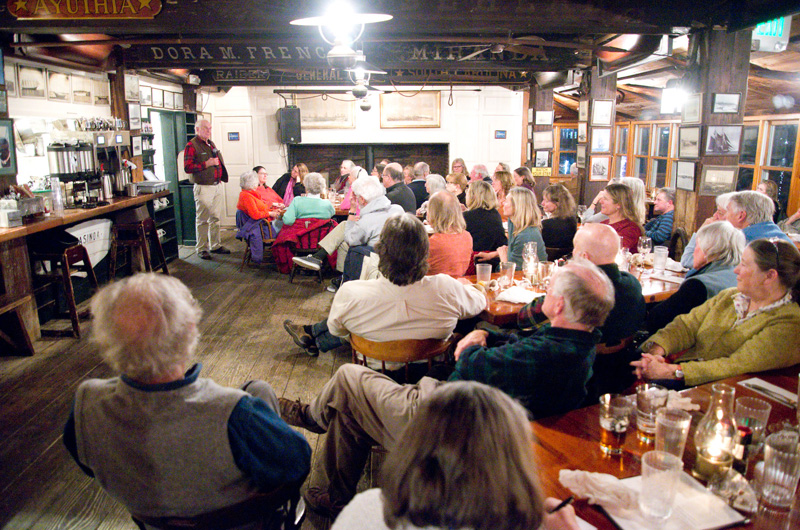A convivial crowd filled the Black Dog Tavern Wednesday night for the first in this season’s Sail Martha’s Vineyard dinner lectures. After mugs of chowder and a hearty meal, the audience sat back to hear the tales from Black Dog founder Capt. Bob Douglas, who has spent well over half a century collecting the maritime memorabilia that covers nearly every vertical surface in his restaurant.
“It’s a rare trove,” Captain Douglas told his listeners. “I’ve tried to fill it out with neat stuff,” such as half-models for whaleboats and the molds used to build a 25-foot catboat on Pasque Island long ago.
Every photo, print, hailboard and model in the tavern has a story of its own, and Captain Douglas shared many of them in a talk that ranged from the age of sail to the high-tech world of modern boatbuilding.
Among the oldest items in his collection are a pair of whaling prints hanging over the cavernous fireplace in the dining room. They were created around 1878, Captain Douglas said, a time when whaling was the dominant industry in the region and crews regularly embarked on years-long journeys across the globe in search of sperm whales and their clean-burning oil.

“Going to the Bering Sea didn’t bother them at all,” he said.
Among the Vineyarders who made their fortunes from whaling, Captain Douglas named Leander Owen of Vineyard Haven, who died in 1911 and whose extensive journals are in the Dartmouth College library.
But the most famous Vineyarder of all sailed a smaller vessel into history with no crew other than himself: Joshua Slocum, who from 1895 to 1898 circumnavigated the globe aboard his gaff-rigged sloop Spray, becoming the first skipper in history to sail alone around the world.
“He grew up in Nova Scotia, but he married a Vineyarder,” Captain Douglas told the rapt audience. “His house is still standing on the side of the Edgartown-West Tisbury Road.”
The hailboards for Scud and Noank, 20th-century replicas of Slocum’s Spray, are hanging from the Black Dog rafters along with many others including the Star Pilot, which worked as a Boston pilot boat until the beginning of the 1970s, Captain Douglas said.
As he spoke, Capain Douglas drew his listeners back in time to an era when it was not unusual for 300 vessels a day to pass through Vineyard Sound. If the wind was unfavorable, he said, fully loaded vessels would stack up in Vineyard Haven Harbor until a shift allowed them to sail out.
A violent storm on Nov. 30, 1898 sank, dismasted or drove ashore more than two dozen vessels in Vineyard Haven, with many lives lost. Twenty years later, a “big freeze-up” trapped maritime traffic again, with the Sound frozen and nobody able to get to or from Nantucket.
The Black Dog also has a photograph from the aftermath of the January 1884 wreck of the passenger steamship City of Columbus, which struck Devil’s Bridge off Gay Head with the loss of more than 100 lives.
The shipwreck didn’t need to be that devastating, Captain Douglas said, but the steamer’s skipper neglected a prime rule of the sea: “When you get in trouble, take a whiff on your pipe.”
Instead, the skipper acted instantly, putting the steamer into reverse at full speed. The underground ledge ripped its hull wide open and the City of Columbus sank alongside the reef.
“He would have stayed dry, but he did all the wrong things,” Captain Douglas said. “Most people aboard died of hypothermia.”
Even outside the tavern’s collection, “you don’t have to scratch very far” to connect with the Vineyard’s maritime history, he said. The stately Old Whaling Church in Edgartown, for instance, is built of wood that was carried here from Maine aboard a whaleship.
And Captain Douglas makes sure, every summer, that young Island kids learn about the Vineyard’s rich sailing traditions aboard the Shenandoah, the 108-foot square topsail schooner he built in 1964.
The children’s favorite activity aboard Shenandoah, he said, is swimming over the side. But they’re also eager to learn about the sea and seafaring history. In fact, he said, if he could he would “bonsai people and keep them all 11 years old.”
“That’s the ideal human brain,” he said.
The next Sail MV dinner is Feb. 7 on the topic Turtlecam Talk, with leatherback turtle experts Amy Kukulya and Kara Dodge. On March 13, Capt. Charles Nethersole will recount the 2016 capsizing of the catamaran Leopard and how all crewmembers made it to shore safely. Dinners begin at 6 p.m. and generally sell out in advance. For reservations and information, visit sailmv.org.







Comments (5)
Comments
Comment policy »